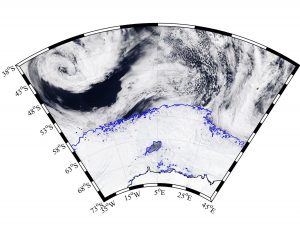
A massive, 30,000 square mile hole has just opened up in the Antarctic ice. (For reference, that’s roughly the size of the state of Maine, the surface of Lake Superior, or the entire nation of Belgium.) A hole such as this — an area of open water surrounded by sea ice — is called a polynya. This particular polynya is located in the Weddell Sea, and while its appearance is puzzling, it is not unprecedented: a similar hole was observed in the region in the 1970s. Precisely what led to the formation of the Weddell Sea polynya is unknown. A typical polynya forms close to open water; this one, however, is “deep in the ice pack” and thus “must have formed through other processes that aren’t understood.”1
While scientific data on the 1970s Weddell Sea polynya is limited to a few photographs taken by early satellites, technological advances since that time offer researchers greater ability to study — and perhaps understand — the hole’s recurrence. As to precisely what caused this hole to open up, I have my own theory:
